Brown Bears of Coastal Katmai
Trip 2 Report,
2011
Brown Bears of Coastal Katmai
Trip 2 Report, 2011
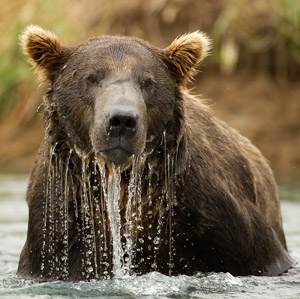
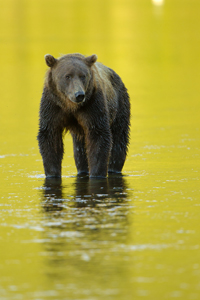
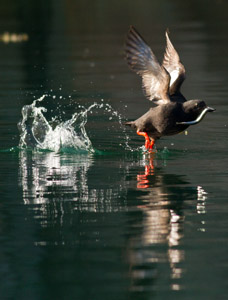

See the PDF Portfolios for both trips for more images
Day 1
Our first group ended and our next group flew in, under the best weather we’ve seen since arriving in Alaska over two weeks ago. Clear skies and warm, with a stiff, autumn-like breeze, and I was tempted to go ashore for a few hours between groups, but another bear-viewing group, and the chance to catch up on office work, kept me inside.
We didn’t expect much for our first shore excursion as the tide was coming in, cresting at 4:30PM and we would not be ashore before 3. The high water provided a short walk to an empty bear viewing area and I expected to show our new group nothing more than the shooting locale, and give them some idea of the distances we’d be working at. It didn’t turn out that way.
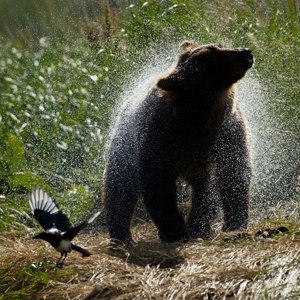 Within twenty minutes of arriving bears began to show, with Scarface, Belou, and the mother and cubs all walking by. All were moving upstream and as the tide advanced, so did we, moving to the last gravel bar before the fresh water meadows and alder thickets. We were expecting a very high tide and I thought we’d be calling for the boat, as I didn’t want our group sitting among the high grasses where a bear, not expecting a human, might walk right into us. Fortunately, the tide didn’t reach as high as it had yesterday, and although our first location was flooded, our new spot was not.
Within twenty minutes of arriving bears began to show, with Scarface, Belou, and the mother and cubs all walking by. All were moving upstream and as the tide advanced, so did we, moving to the last gravel bar before the fresh water meadows and alder thickets. We were expecting a very high tide and I thought we’d be calling for the boat, as I didn’t want our group sitting among the high grasses where a bear, not expecting a human, might walk right into us. Fortunately, the tide didn’t reach as high as it had yesterday, and although our first location was flooded, our new spot was not.
Through the afternoon the tide eventually receded and we moved back down stream, where we filmed multiple bears, getting 10 or more for the afternoon. We faced west, so the light was tough, but we had several opportunities for bears shaking wet fur. The best chance we had was partially ruined by a black-billed magpie that flushed when the bear shook, with the bird flying straight across the bear!
By late afternoon we were in shirt-sleeves, and when the wind stopped black flies suddenly appeared, making the last hour or so a bit vexing as insects hovered about. Some bit, but most simply annoyed us. Our day ended with our first dinner, a mix of fantastic barbeque pork ribs and chicken, with plenty of funny stories from past trips.
Day 2

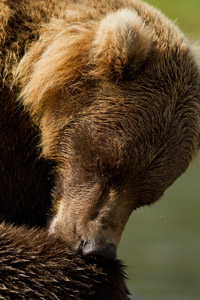
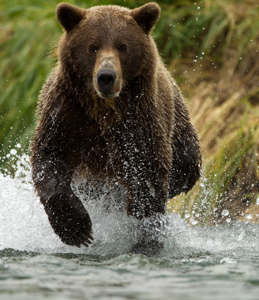
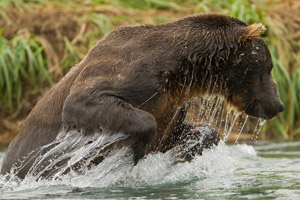

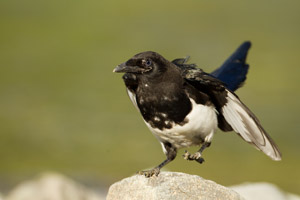 We awoke to a cloudless sky, blue and bright, the most spectacular clear day we’ve had in Alaska this year. The tide was out and low, and our hike in to our viewing area was punctuated by several stops. One female bear, feeding and chasing salmon at the mouth of the stream, tempted us with her reflections but by the time we set up she had moved deeper into the stream. We continued, and as our angle changed we noticed that the bear, still in the shade of the mountain ridges, was surrounded by lemon Gatorade-colored water, and now, with our gear out, we were ready for shooting. Another bear had passed close by and was now feeding on clams, and a few of us, Judy, Jim, Ann, and me, headed out to try to get some shots with the bear framed against the sunlit mountains. The female fed completely unconcerned by our presence, although we stayed just out of frame-filling range.
We awoke to a cloudless sky, blue and bright, the most spectacular clear day we’ve had in Alaska this year. The tide was out and low, and our hike in to our viewing area was punctuated by several stops. One female bear, feeding and chasing salmon at the mouth of the stream, tempted us with her reflections but by the time we set up she had moved deeper into the stream. We continued, and as our angle changed we noticed that the bear, still in the shade of the mountain ridges, was surrounded by lemon Gatorade-colored water, and now, with our gear out, we were ready for shooting. Another bear had passed close by and was now feeding on clams, and a few of us, Judy, Jim, Ann, and me, headed out to try to get some shots with the bear framed against the sunlit mountains. The female fed completely unconcerned by our presence, although we stayed just out of frame-filling range.
We didn’t have long to wait at our viewing area before bears arrived, feeding in a variety of methods nearby. Several captured salmon and walked right passed us, or fed on shore close by, giving some great views. Two different females with cubs worked the stream as well, although nothing exceptional occurred.
With the bright sunlight contrast and dark shadows was an issue and we changed positions near the end of the shoot, finding a spot that tomorrow, if it is sunny, we’ll take for a different view and angle.
After a huge lunch we did our first bald eagle skiff ride, and had success with one immature that cooperatively perched upon a small rocky islet, and a few adults that flew by. The steep, cliff-side nest we worked last week still had an immature eagle inside, and shortly after we left it an adult flew in. We returned, and obtained some decent images of both the adult, perched twenty or thirty feet above the nest on a ledge, and the juvenile still in the nest.
Day 3
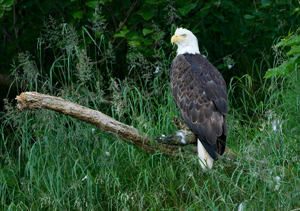
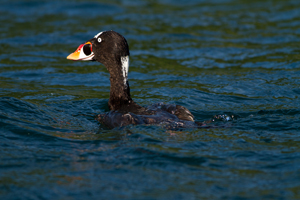
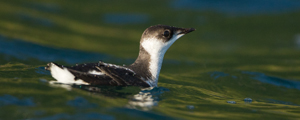
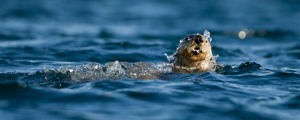
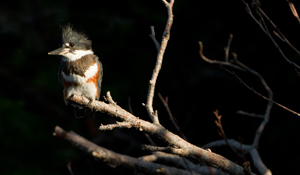
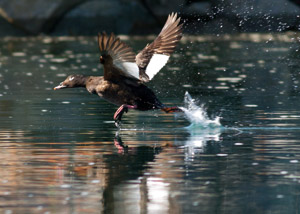
Top Row: Bald Eagle, White-winged Scoter. Middle Row: Marbled Murrelet, Sea Otter. Bottom Row: Belted Kingfisher, White-winged Scoter.
Another incredible weather day and incredible subjects to match. We landed on the beach shortly after 9, with a heavy fog that masked the mountains surrounding our bay. The effect was ethereal, and we tried incorporating the fog with the bears feeding along the stream but with our long lenses the result was just a gloomy looking bear. More distant bears, while having less detail, did a better job of catching the ambience, and although we tried moving closer to the stream and using shorter lenses, to really catch the foggy landscape, no bears passed nearby.
 We headed to our new viewing spot and the action, at first with moderate action, not fast, not slow, but as the fog burned off the light brightened and, from this vantage, we had no trouble with distracting contrast and shadows. Several new bears showed up, including one so fully furred that it resembled a Sloth Bear from India, and we named this big-haired bear Farrah. Blondie, a bear we’d seen two years ago, appeared again today, with a two year old cub in tow.
We headed to our new viewing spot and the action, at first with moderate action, not fast, not slow, but as the fog burned off the light brightened and, from this vantage, we had no trouble with distracting contrast and shadows. Several new bears showed up, including one so fully furred that it resembled a Sloth Bear from India, and we named this big-haired bear Farrah. Blondie, a bear we’d seen two years ago, appeared again today, with a two year old cub in tow.
In late afternoon, with a slight breeze ruffling the bay, we did another skiff ride for eagles and had the best luck we’ve had since we’ve been here. Chuck, the captain, drove the skiff and his thirty years of experience here as we came in closer to adult eagles than we ever had. Our first eagle was perhaps the best, and when we finished doing everything we felt we could we carefully backed out, rather than pushing further for a flight shot, and left the eagle undisturbed. Hopefully we’ll get another chance at her and she’ll be equally laid back, as positive experiences can habituate a wary subject.
In our nearly three hours of boating about in the skiff we photographed Sea Otter, Red-necked Grebe, Pelagic Cormorant, frame-filling Black-legged Kittiwakes and Black Oystercatchers, Surf and White-winged Scoters, Pigeon Guillemots, Common Murre, Marbled Murrelet, and a fairly cooperative Belted Kingfisher. In a boat, especially a small skiff on slightly wavy waters, there are a lot of missed shots, and as I did my first cull, using Breeze Browser, I deleted 19 gigs! However, I still have over 10gb to look at more closely, so there will be some real keepers here.
As I write this the clear skies are gradually fading as another low hanging fog rolls in from the sea, giving the steep walled bay a ghostly, beautifully eerie quality.
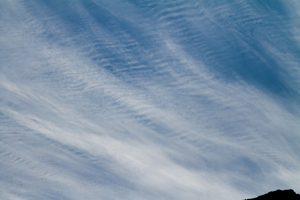
Day 4 and 5
We awoke to the sound of rain on our portholes and, when we came on deck, the sight of a gradually increasing storm front. The magical light of the first three days had vanished, replaced by a steady wind whose progress was eerily reinforced by the wind generator atop our ship, creating a near constant ‘warooomming’ hum as the four blades spun. Sheets of rain created bands that passed across the mountain, teasing us at times with a slight drizzle that provided some hope that we would land and photograph then cruelly bringing us back to reality as heavy rains blasted against the glass. At times the boat sounded as if the craft was passing through a car wash, as the glass rattled with the force of a sudden squall.
We passed the first day editing, and looking at the portfolios that everyone brought for show, and the collection of images we made on our three days of shooting. With a good group, and a lot of work to do, the days passed pleasantly, with a lot of stories, political and climatic opinions shared, and more food than we could eat. Now, our only concern is that the storm will clear enough to allow us to fly out and catch our flights home. Yesterday, Day 4, all flights from Anchorage to Kodiak were cancelled, so this has been one big storm!
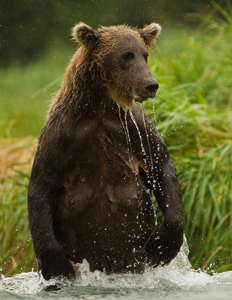 On the afternoon of Day 5 Doris, Judy, Ann, and I went back onto the beach despite the rain. The heavy rains had abated, but it rained continually. It was not a drizzle, and the women shot beneath umbrellas, plastic bags, or rain covers. I huddled beneath a heavy poncho that I draped over the sea, providing a fair measure of protection, with my camera protected by a Kuba camera protector and my 500mm lens with a FotoSharp long lens waterproof cover, which worked wonderfully.
On the afternoon of Day 5 Doris, Judy, Ann, and I went back onto the beach despite the rain. The heavy rains had abated, but it rained continually. It was not a drizzle, and the women shot beneath umbrellas, plastic bags, or rain covers. I huddled beneath a heavy poncho that I draped over the sea, providing a fair measure of protection, with my camera protected by a Kuba camera protector and my 500mm lens with a FotoSharp long lens waterproof cover, which worked wonderfully.
For all of these shoots Mary and I carried our 500mm f4 lens for our principle shooting, which often gave us full-frame face shots when bears fed close by. Mary used her 28-300 more frequently than I, and I may have been lazy as I used my very light weight 70-200 f4 lens for my closer bears. Often I wished I'd had the wider zoom, because of the animals in habitat that I missed. I never used my flash except for some people or boat cabin shots. We carried all of our gear in our Keboko backpacks, and on this second trip 7 of our 8 shooters had these light weight and very versatile backpacks.
The heavy rains of the last two days raised the stream levels by nearly a foot, and negoiating the normally shallow, easy streams was a bit challenging. We could feel the current against our legs, and with slippery rocks, the crossing was risky but we reached our viewing area uneventfully. Bear activity was slow, as it had been the last two days as we watched the stream from the boat, but Scarface or Whinny Bear and his mom, and Sleepy, a big dark brown, nearly black bear with a distinctive cut on his elbow, and three other bears worked the stream. High ISOs were needed; I used ISO 2000, but the shooting was rewarding, with the momma bear doing one great leaping dive, followed by standing on her hind legs, water cascading from her fur, and a couple of good passes with Scarface.
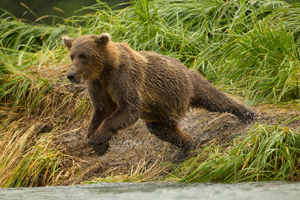 That evening, as we reviewed our bear portfolios as a group slide show (via computer, of course) it was surprising to see how many of that afternoon's shoot were included in the 'favorites.' For all the rain, the chillness, and the relative slowness of the shooting, the results were worth it. Two days earlier, a few photographers sat out our skiff ride, which turned out to be the best of the two weeks. So, the lesson here obviously is to take part in every shooting opportunity offered, as each provided opportunities that were unique, and not repeatable.
That evening, as we reviewed our bear portfolios as a group slide show (via computer, of course) it was surprising to see how many of that afternoon's shoot were included in the 'favorites.' For all the rain, the chillness, and the relative slowness of the shooting, the results were worth it. Two days earlier, a few photographers sat out our skiff ride, which turned out to be the best of the two weeks. So, the lesson here obviously is to take part in every shooting opportunity offered, as each provided opportunities that were unique, and not repeatable.
As darkness settled, the rain had almost stopped and the mountains surrounding our bay were clearly visible, lending much optimism to our chances of flying out tomorrow. No flights left Kodiak today or yesterday, so we could only hope that tomorrow's weather would cooperate.
Day 6
We awoke to rain, but Chuck, our captain, radioed our sea plane operator and it looked as if we'd fly. Our flight was scheduled for late morning and as we waited the rain increased and the skies lowered. Still, there was optimism, and the sea plane arrived on schedule. We flew out just 150 feet 'above the deck,' close enough that we could bird-watch as we cruised above the waves. I was hoping to see an albatross, but aside from a dark bird, likely a gull, and the many bald eagles we saw perched on the outlying islands as we left the bay, we saw nothing of importance. As we neared Kodiak our pilot pointed out a big pod of Sea Otters that lulled on their backs unconcernedly as our plane passed close by. Coincidentally, while we waited on our boat a Sea Otter swam by, the first we've ever seen this close to the head of the bay.
We had a few hours to explore the town of Kodiak, and Jim, Dave, and I visited the Kodiak National Wildlife Refuge Visitor Center. It was well-done, with carved, rather than stuffed, bears, mounted salmon, and carved birds. A push-button telephone interpretation of salmon was interesting and informative. The Pink Salmon, the species we were seeing running our streams, is named not for its skin color but for the color of their flesh. Pink's also have the largest hump, a dimorphic trait in males that developes as the salmon begin their final, spawning migration. Pink's, like the slightly larger Dog Salmon, breed in the intertidal zone, not very far upstream, and their fry return to the sea early. Chinook, or King Salmon, in contrast, swim far upstream, breeding in the feeder streams of distant lakes, and their fry spends a year or longer in the fresh water streams.
Most salmon species, including the Pink, spend only two years at sea before returning to their spawning grounds where they will mate and die. According to the Interpretative Center, 700,000 Pink Salmon and 700,000 Red or Sockeye Salmon congregate at the mouth of just one river on Kodiak, so the total numbers are staggering. This influx of fresh protein fertilizes the landscape, mainly through bear droppings, as the bears on Kodiak and in Katmai congregate in numbers during the salmon spawning run. On Kodiak, in 1 sq mile, 220 bears may congregate, while in Denali 1 bear may be found in 12 square miles. These figures, however, are a bit misleading, as it incorrectly implies that there is a bear density of 220 bears per square mile across Kodiak, while the figure cited must refer only to the spawning streams. At Katmai, we saw as many as 20 bears in our stretch of beach, less than a square mile in area, less than 1/10th the density numbers the IC cited for Kodiak. Somehow, this data seems a bit skewed, as even at McNeal River, famous for its bear density at the falls, has only a few dozen bears visible at any time. So ... perhaps there is a misprint in the IC?
As I write this, we are waiting for our ERA flight back to anchorage, the first leg of a long, red-eye flight back home. We're lucky, as no flights left Kodiak yesterday, and although the numbers varied somewhere between 2,000 and 5,000 pieces of luggage were stranded in either Anchorage or Kodiak.
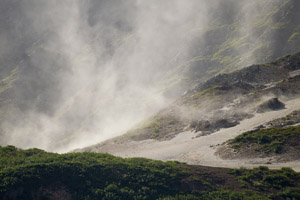

High winds blow residual volcanic ash still coating the slopes of the mountains surrounding our bear-viewing bay from an eruption that occured in 1912. That eruption was the equivalent of 100 Mount Saint Helens eruprtions! A bald eagle flies close on one of our skiff rides.
We will be doing this trip again in August of 2013. The trip is limited to 6 participants, with Mary and me leading the trip(s). Contact our office if you are interested -- spaces are obviously very limited!
If you'd like to see our other years' various Trip Reports, and photos that help to illustrate the story, check out the Home Page and the reports listed there, or click on any of these links:


